The 16-Gauge Rides Again on South Dakota Prairie
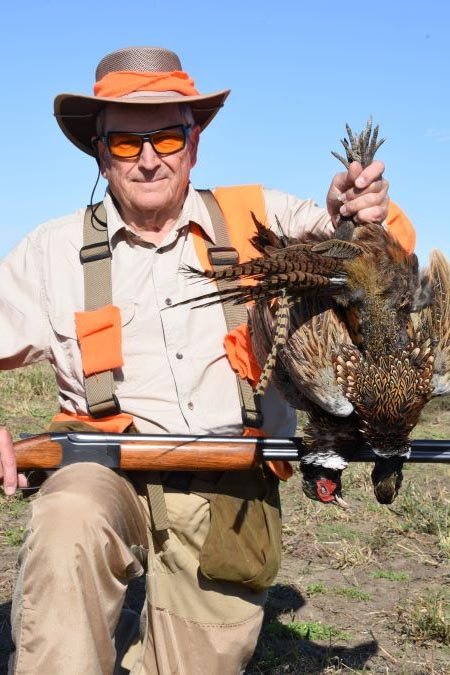
Greg Graham of Little Rock Arkansas favored his vintage Marlin Model 90 over his Browning Citori Gran Lightning 16 gauge for early season pheasants.
I became a fan of the 16-gauge in 1975, at age 12, during a south Arkansas deer hunt with my next door neighbor, Todd Hickingbotham.
Todd used a Remington 1100 16-gauge owned by his brother Herren Hickenbothom. We were kids, long before their dad’s company, TCBY Enterprises, made them fabulously wealthy, but that shotgun made an impression on me.
The gun itself was unremarkable, but I fancied that number. Sixteen-gauge. I liked the way it sounded, and I came to love the way it suits me.
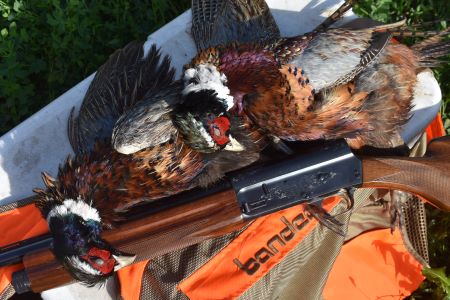 The author has many 16-gauges, but he prefers his Browning Auto-5 Sweet Sixteen.
The author has many 16-gauges, but he prefers his Browning Auto-5 Sweet Sixteen.Arkansas is 12-gauge country, but the 12 seemed brutish. My family hunted ducks at close range in green timber when it was still legal to hunt waterfowl with lead shot. The firepower seemed excessive, but the 12-gauge was also a “pack” gun. Every adult in my universe used them, and every youngster aspired to them.
The 16-gauge is a confident non-conformist. The 12-gauge, with its 3- and 3½-inch shells, tries to be a 10-gauge. The 20 tries to be a 12. Even the .410-bore tries to be a 28-gauge.
The 16 and the 28 remain true to themselves.
I have amassed a safe-full of 16-gauge shotguns, and I always look forward to using them in an annual outing among friends with Wild Wings Hunting Services in Gregory County, South Dakota. The group includes sometimes more than 20 members, with a core consisting of federal district judge Billy Roy Wilson, attorney Greg Graham of Little Rock, former Arkansas state representative Monty Davenport of Yellville, and attorney Skip Henry of Little Rock, grandfather of Los Angeles Chargers tight end Hunter Henry.
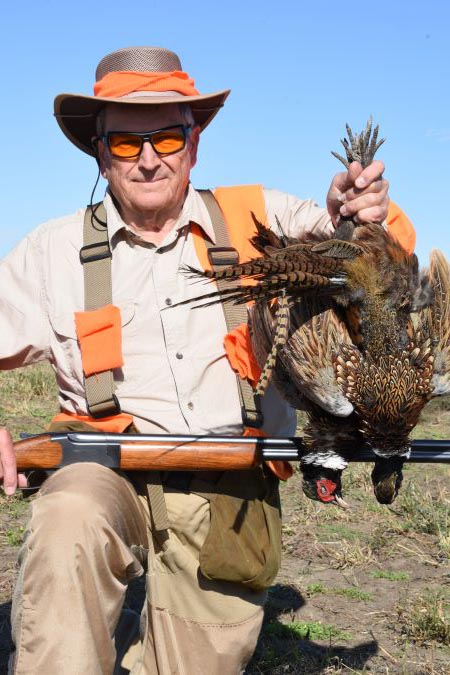 Greg Graham of Little Rock Arkansas favored his vintage Marlin Model 90 over his Browning Citori Gran Lightning 16 gauge for early season pheasants.
Greg Graham of Little Rock Arkansas favored his vintage Marlin Model 90 over his Browning Citori Gran Lightning 16 gauge for early season pheasants.Wilson has hunted annually with Wild Wings since 1973, when as an attorney he befriended Wild Wings founder Rick Johnson at a conference. Avid upland bird hunters and muleskinners, they became like brothers. Rick is deceased, but his International Harvester Travelall rests on a high hilltop above one of Wild Wings’s best fields as a memorial.
Johnson’s son George, who owns Wild Wings with his uncle Jeff Johnson, worked for Wilson as a law clerk before returning to South Dakota to launch a successful legal career. Gavin Pochop, George’s cousin, also served as Wilson’s law clerk. He also returned to South Dakota to practice law, and he assists in Wild Wings operations, as well.
Now, George’s young sons Fielding and Nicholas tag along in the pheasant fields, making it a three-generation family affair.
Wilson, by way of my columns in the “Arkansas Democrat-Gazette,” and because of his deep respect for my late father, invited me into this circle. My dad, Wilson said, was the only judge ever to preside over a trial by phone. Wilson represented one of the litigants.
“That’s how much we trusted him,” Wilson said.
The 16-gauge embodies a vast upland hunting tradition. Unsheathing a 16 during a pheasant hunt is like riding across the prairie on a steam locomotive. It conveys a certain purity, and it respects the upland bird hunting tradition.
The Browning Grade III BPS (a 2008 SHOT Show Special) that I used for my first hunt turned a lot of heads. The following year I brought a Browning Auto-5 Sweet Sixteen and, at the request of its former owner, a 1950 Winchester Model 12.
The next year, the 16-gauge took root. Wilson replaced his 28-gauge Browning BPS with a 16-gauge Remington Model 870 Wingmaster. In 2018, Davenport shelved his 20-gauge in favor of a new Browning A5 Sweet Sixteen. Graham brought a Browning Citori Gran Lightning (a 2018 SHOT Show special) and an immaculate Marlin Model 90 over/under. The Browning is more handsome, but Graham prefers the spartan Marlin.
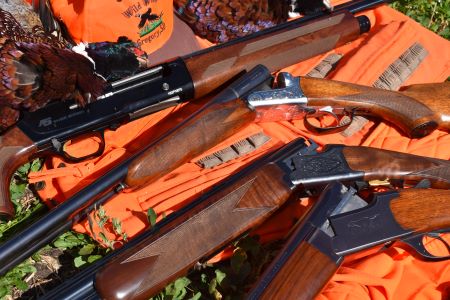 Sixteen-gauge shotguns ruled the field while hunting with Wild Wings near Gregory, South Dakota. Selections included, from top, a new Browning A5 Sweet Sixteen, the author’s Beretta Silver Hawk, a Browning Citori Gran Lightning and a Marlin Model 90.
Sixteen-gauge shotguns ruled the field while hunting with Wild Wings near Gregory, South Dakota. Selections included, from top, a new Browning A5 Sweet Sixteen, the author’s Beretta Silver Hawk, a Browning Citori Gran Lightning and a Marlin Model 90.Gregory (population 1,255) calls itself the “Pheasant Capital of the World.” A giant statue of a pheasant rooster greets visitors near the town square near Gregory High School – home of the Gorillas – a nine-man football powerhouse. The rolling terrain of Gregory County grows vast swaths of corn, milo and millet alfalfa and prairie grass. They form a tapestry of feeding and escape cover for pheasants whose numbers are augmented by preserves like Wild Wings that raise and release birds.
Hunting pheasants early in the season on a private preserve like Wild Wings is always stellar. Birds are plentiful, and they were not as flighty as they will be later in the season. Roosters often hold tight, and hens flush almost underfoot. Birds that elude hunters get educated quickly.
“Later in the season, they’ll flush at the slamming of a car door,” George Johnson said.
A pheasant hunt is like a small military operation. A squad of walkers – usually the youngest and most physically fit in a group – form a line that walks the breadth of a field. The grass and grain stalks are often chest-high, and sometimes even head-high. Shouting and kicking, the walkers shoot at birds that fly straight up or down a field. The line must be straight to minimize the risk of shooting at or over another hunter when a bird flies behind the line.
 Despite dry, windy conditions, Gregory County’s pheasants cooperated for a group of Arkansas hunters during their annual visit to Wild Wings. A quartet of hunters used 16-gauge shotguns to fold a good number of birds.
Despite dry, windy conditions, Gregory County’s pheasants cooperated for a group of Arkansas hunters during their annual visit to Wild Wings. A quartet of hunters used 16-gauge shotguns to fold a good number of birds.Pheasants generally fly only as a last resort to escape danger. They run from trouble, and they are fast. They are also small enough to dart low through cover ahead of the dogs. Sometimes the cover is so thick that even the birds get tangled, as do the dogs. When you hear thrashing in the stalks, it means a dog can’t quite catch a bird that can’t quite get away. You’d better be ready for a flush.
Flankers bracket the field edges. There are usually three flankers on each side about 30 to 40 yards apart, and they walk in front of and parallel to the walkers. They shoot at birds flying out the sides of the field.
At the end of the field is a squad of blockers. They shoot at birds that fly out the end of the field. A blocking station can be a prime position because all of the birds that have run ahead of the walkers have no choice but to fly when they encounter the blockers.
The end of a field can be chaotic because all of the birds that haven’t flushed are penned up tightly among an army of concentrated shooters. When a bird finally flushes, they all flush, spurting like fireballs from a Roman candle. Discipline in such close quarters can evaporate among casual acquaintances, but this group has hunted together for so long that safety is second nature.
Instead of setters and pointers, the guides at Wild Wings mostly use Labrador retrievers. The exception is Helga, Wilson’s aging German shorthair. She is on permanent loan, and she is an excellent hunting dog.
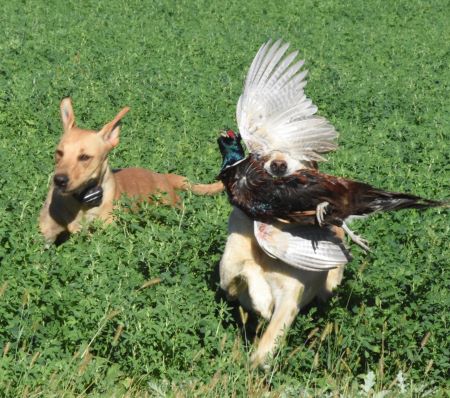 Retrievers get plenty of work in early season hunts at Wild Wings.
Retrievers get plenty of work in early season hunts at Wild Wings.The Labs point pheasants that hold, but generally roosters flush ahead of the dogs. However, the dogs work close enough that birds are almost always in range when they flush.
Walking through the cover is arduous for dogs and hunters, and it burns a lot of calories. Because the weather is warm in the early season, dogs tire quickly, and the guides rotate fresh dogs into each new field. Though tired, the other dogs greatly resented being benched and hurl vile insults at fresh dogs when released.
For the 2019 hunt, I brought a 1965 Beretta Silver Hawk side-by-side and my trusty Auto-5 Sweet Sixteen.
My Auto-5 Sweet Sixteen is a Miroku version with Invector chokes. I get a lot of grief from purists that only respect Belgian-made Auto-5s. I have owned both. I love them all for one simple reason. Regardless of the factory of origin, I shoot the Auto-5 better than any other shotgun.
 Shots are often close on tight-holding early-season pheasants in South Dakota.
Shots are often close on tight-holding early-season pheasants in South Dakota.The Model 409 Silver Hawk boasts graceful lines and a strawberry blond finish on plain, straight-grained walnut. Like Graham’s Marlin 90, a gun nearly as old as I am, it has some stories to tell.
Its barrels are 26¼-inches long. The bore constrictions are .638 on the left, and .645 on the right. Two stars adorn the underside of the left barrel, and the right barrel has three stars. I am unable to find a reference to the star designations, but the constrictions correspond to improved modified for the left and light modified for the right. The receiver area is polished nickel with scroll engraving. It has a single, non-selective trigger and extractors.
The 16-gauge Silver Hawk was custom made for the pheasant fields. It carries light and comes to the shoulder crisply, instantly aligning my eyes to the muzzles. It swings fast and points faster, so you have to slow down to swing on close-flying birds.
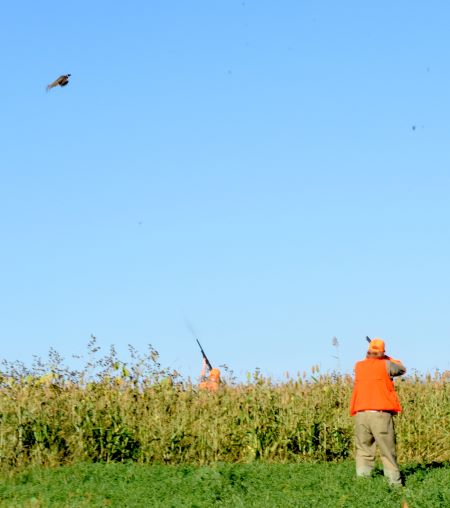 Quick instincts are called into play to down these early-season pheasants at Wild Wings.
Quick instincts are called into play to down these early-season pheasants at Wild Wings.I started the hunt by downing a cock with a long right-to-left crossing shot from my flanker position. Despite intense wind, I folded others with one-ounce loads of No. 6 lead.
I recorded these kills with a GoPro camera strapped to my cap. The video captures the entire tableau of a South Dakota pheasant hunt. The wind roars. Grass, corn and milo wave wildly. A bird flushes and crosses in front of a vast expanse of green with distant highlands known as the “Buttes” in the background. The camera looks down the twin barrels. A viewer’s eyes follow its lead. One barrel barks, and a rooster folds, plummeting in a slow, tumbling arc.
It’s how I envisioned it as a child when articles about pheasant hunting by writers like Ted Trueblood captivated my imagination.
I watch the videos often, but the real thing? I see that in my dreams.
Bryan Hendricks, an avid shotgunner, is the Outdoors Editor for the Arkansas Democrat-Gazette in Little Rock, Arkansas. He also served eight years with Missouri Department of Conservation and the Oklahoma Department of Wildlife Conservation. He has credits in more than 1,000 articles in nearly 80 publications worldwide.
Useful resources:
The web site for Wild Wings

Bryan Hendricks, an avid shotgunner, is the Outdoors Editor for the Arkansas Democrat-Gazette in Little Rock, Arkansas. He also served eight years with Missouri Department of Conservation and the Oklahoma Department of Wildlife Conservation. He has credits in more than 1,000 articles in nearly 80 publications worldwide.


Comments